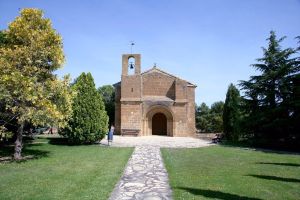The chapel of San Juan was constructed in the medieval era (13th century) and has been at the receiving end of many modifications over the centuries. The remains that can be seen near to the current building correspond to a large but primitive church that once stood there, with a rectangular nave split into two sections and a polygonal east end.
Close to these archaeological remains there is a human tomb excavated from the rock. The existence of an isolated grave that does not form part of a cemetery of necropolis expresses social and economic differences and suggests that an important individual was buried here. In that era, the majority of people were buried anonymously in huge communal cemeteries, or even in a patch of open ground. The existence of an everlasting grave carved from rock indicates that the person was worthy of special treatment, although we cannot be sure why.
Assuming that the person was well-off, he would have been wrapped in a shroud of white cloth soon after death and watched over by family members before being carried to this spot, accompanied by a solemn entourage of hired mourners. During the journey the mourners would have listened to hymns, prayers and wailing and the church bells would have rang out to frighten off the demons.
In Peralta de Alcofea, daybreak would arrive to the sound of the church bells as a way to awaken the workers. At 11 ‘o’ clock they would ring out again to mark the departure of the women as they set off to take food to the labourers in the fields.
If a traveller got lost in the mountains, the sound of the San Juan bells would help him get his bearings as they rang out every evening; around 6 ‘o’ clock in winter and 8 ‘o’ clock in the summer.
However, in addition to marking a daily rhythm in the village and helping the lost, the magical sound of the bells was also capable of “conjuring away” storms and keeping hailstorms at bay.
The chapel is dedicated to San Juan Bautista (St John the Baptist) the most celebrated saint in Europe. For centuries the arrival of the summer solstice has been one of the most important events of the year for many villages across Europe. To coincide with this date, the night of the 23rd – 24th June sees the celebration of the birth of St John the Baptist to Isabel, the cousin of the Virgin Mary. The date also falls 6 months before the winter solstice and Christmas, the birth of Jesus. His feast day is accompanied by a series of rituals, practices and customs that appear to originate in pre-Christian times.
On this night, the shortest of the year, the triumph of light over dark is celebrated and the lighting of bonfires takes on a special significance. Fire, a legacy of old pagan cults that worshipped the sun, keeps away bad spirits and helps to renew energy.
It is a magical night when anything can happen; plants take on special properties, young girls find boyfriends and love has no bounds. Water fairies and mystical washer women walk freely near rivers and fountains, secret caves are suddenly accessible to mere mortals and hidden treasure can be discovered with ease.
Many years ago in Peralta, men and women would go to collect water from the pool before daybreak. Upon arrival at the pool they would remove their clothing and swim in the water. Also on that night, a bunch of esparto grass would be placed in walnut trees to prevent the nuts from being eaten by worms.




